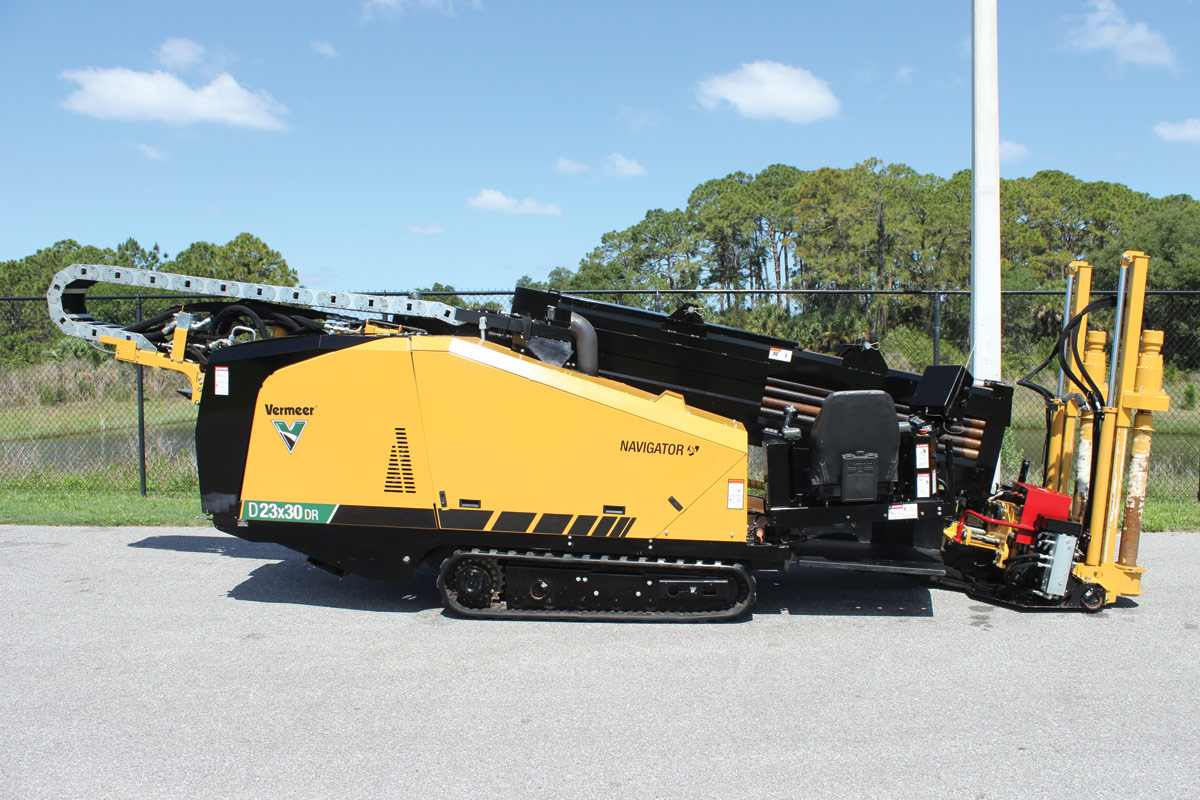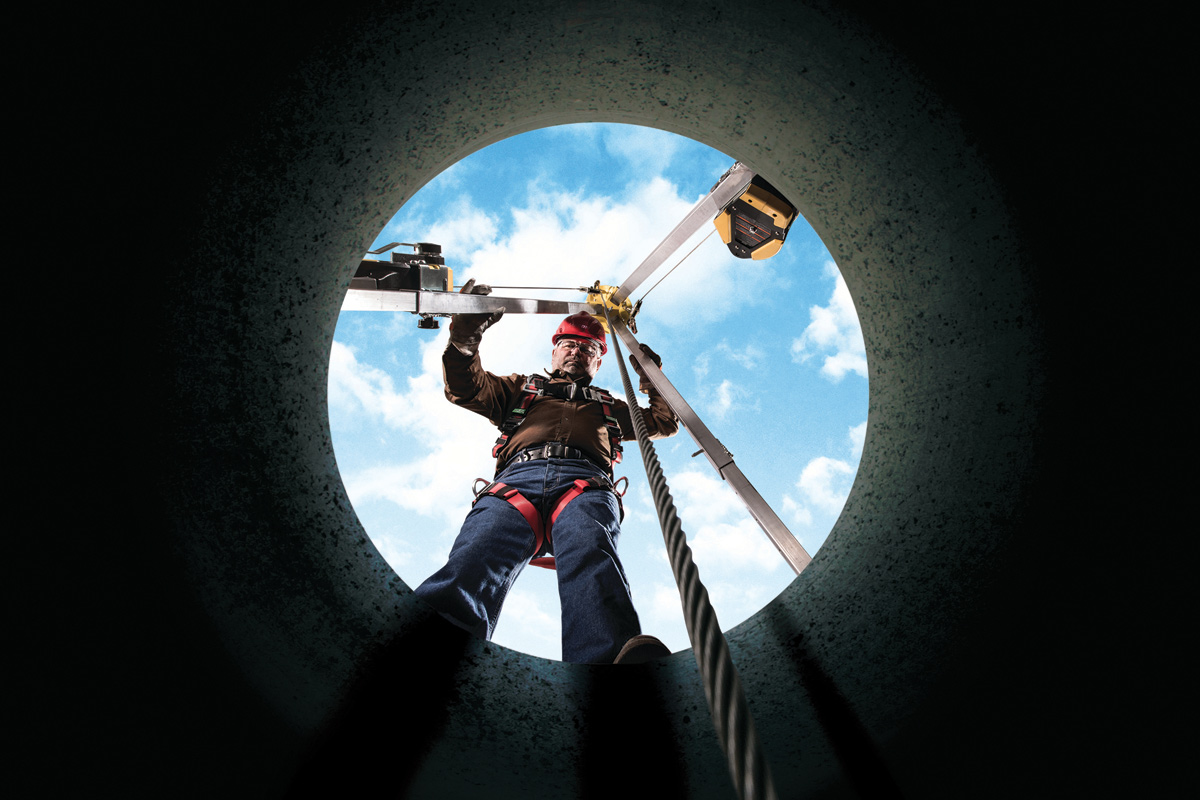2003 Trenchless Technology Person-of-the-Year: Irene McSweeney Woodfall
 Irene McSweeney Woodfall describes herself as a “quiet advocate” for trenchless technology. But her professional actions over the last 18 years reveal otherwise.
Irene McSweeney Woodfall describes herself as a “quiet advocate” for trenchless technology. But her professional actions over the last 18 years reveal otherwise.
She is an active advocate for trenchless technologies through her countless hours of work through the North American Society for Trenchless Technology (NASTT) and the Northeast Chapter for NASTT. She mentors students within the NE Chapter and has taught courses at her alma mater, Wentworth Institute of Technology, incorporating trenchless into her coursework.
Irene has given numerous project presentations during her professional life, detailing the good and the bad of various trenchless projects with the hopes that others will learn from each one. Irene was also project manager on the 1996 Trenchless Technology Project of the Year (St. James Avenue Interceptor Project) and she is currently working on completing her master’s degree in civil engineering.
A quiet advocate? Hardly.
And her peers have added another notation to her already impressive resume. Irene McSweeney Woodfall is the 2003 Trenchless Technology Person of the Year.
“I was shocked and very honored” Irene said when she learned of the award. “I really have always considered myself a quiet trenchless advocate. … I am more of a behind-the-scenes kind of person. “As a public agency, you have a responsibility at a higher level to ensure public safety,” adds Irene, Director of Construction for the Boston Water and Sewer Commission. “Sometimes contractors will try to convince you that an alternate method is the best way to go and they are looking at which method makes them the largest profit. You have to balance the benefits vs. the incentive. A lot of times, agencies are considered the easy side of the industry, but I think you have a huge responsibility that oftentimes people don’t think you take seriously and we really do take that very seriously.”
“Irene is a dedicated and competent professional who has consistently maintained the highest of integrity in all of her dealings,” says Mark Wallbom, NASTT chairman. “Her commitment to the Boston Water and Sewer Commission is personal and she is vigilant in her oversight of projects under her jurisdiction.
“She is a realist and gives prudent and unbiased consideration to alternatives should the circumstances dictate. Irene brings great credit to herself, the Commission and to this industry by the way she listens, the way she leads and the way she gives back through her service in organizations such as ASCE, NASTT and others.”
Irene’s commitment to the trenchless industry motivates her to share her knowledge, experience and perspective of trenchless technologies to other interested municipalities and, more importantly, to future engineers. Her position with the Boston Water and Sewer Commission (BWSC) puts her in the perfect position to do so — Boston just happens to be one of the more progressive and aggressive cities in the United States that utilizes trenchless technologies to their fullest potential in the rehabilitation of its infrastructure.
Background
Originally from New York, Irene graduated with a bachelor of science degree in civil engineering in 1983 from Wentworth Institute of Technology in Boston. Fresh from college, she was hired as a design engineer for Allen & Major Associates, a consulting firm in Woburn, Mass., outside of Boston. There, she was the designer and construction manager on numerous commercial, industrial and residential projects, specializing in theatre complexes, office parks and residential subdivisions.
“We did everything from site development to roadway construction,” Irene says.
She eventually rose to the title of senior project manager and remained at the consulting firm for eight years, leaving for the Boston Water and Sewer Commission in 1991.
Irene joined the Commission as a project engineer, where she oversaw water, sewer and drain replacement and rehabilitation projects valued at $500,000 to $2 million. A few of the projects she was involved with included the cleaning and cement lining of five miles of 48-in. water mains on Tremont Street and Brookline Avenue, water main replacement of 6- to 16-in. water mains and appurtenances, sewer rehabilitation of the South Boston Interceptor, shotcrete lining of 72-in. sewer and sewer rehabilitation projects in Jamaica Plain and Roxbury valued at $10 million.
Irene was promoted in 1995 to the Deputy Director of Construction where her responsibilities grew beyond project management to include scheduling for 15 inspectors and the technical review of six project managers. The sewer and drain projects put under her supervision were valued between $1.5 and $17 million.
Among these projects in which she played a key role in was the award-winning St. James Avenue Interceptor Project — a $17 million project that incorporated nearly every trenchless method in the books. Among the techniques incorporated into this massive project were microtunneling, pipe bursting, shotcrete lining, CIPP lining, point repairs, manhole rehabilitation and relay of a surcharged sewer system in the Back Bay area of Boston. The much-honored project finished under budget and two years ahead of schedule.
The St. James Avenue Interceptor Project was recognized as the Trenchless Technology Project of the Year in 1996, as well as the 1996 Outstanding Achievement Award from the Boston Society of Civil Engineers. “Almost every trenchless method was employed in this highly urban area in Boston,” Irene says.
In 1998, she was named to her present position, Director of Construction, where she leads a staff of 40 engineers and inspectors and is responsible for a $63 million construction contract budget. Irene also remains involved and responsible for the City’s most expensive and challenging sewer and drain projects. She is the project manager for the Dorchester Sewer Separation Project — a seven-year, $140 million sewer separation project that was court-mandated. She also is assisting in the project management of a five-year, court-ordered $50 million sewer separation project called the Stony Brook Sewer Separation.
The Boston Water and Sewer Commission is the largest retail water and wastewater utility in New England; the Commission oversees more than 1 million daytime utility customers and 600,000 nighttime customers. BWSC is also progressive in its thinking of rehabilitating its infrastructure and is a vocal advocate of trenchless technology methods.
Among its current projects is the much discussed Big Dig highway project, where a six-lane elevated highway is being replaced with an eight- to 10-lane underground expressway directly beneath the existing road, culminating at its northern limit in a 14-lane, two-bridge crossing of the Charles River. BWSC’s role in this mammoth transportation effort is the relocation and installation of utility lines.
Irene says she’s proud of the trenchless work the Commission does and feedback from complete strangers from other municipalities and agencies tells her that BWSC’s work, knowledge and experience with trenchless technologies is held in pretty high regard.
“I recently got two e-mails from other agencies, asking for information relative to a couple of projects that we have done and asking for my opinion on what methods would be worthwhile to pursue for their projects,” Irene says. “People trust our opinions.”
Introduction to Trenchless
Irene says she studied trenchless technologies a bit while at Wentworth Institute of Technology but the curriculum really didn’t focus on that aspect of engineering. Her exposure and experiences with the industry came primarily when she joined BWSC. Her first full-blown foray into trenchless technology came with the St. James Avenue Interceptor Project that, as stated above, employed nearly all trenchless methods.
“If it’s the right application, [BWSC] will try new technologies because we know the benefits of using trenchless,” Irene says. “Trenchless technologies are used in probably half of the utilities work that the Commission does. The majority of our water program is cleaning and cement lining and we also do a lot of sewer work. We do replacement with pipe bursting, sewer lining, point repairs on our sewer system, manhole rehabilitation, microtunneling, CIPP … there aren’t many trenchless technologies that we haven’t done. We also have done sewer lateral lining repairs and thousands of feet of TV inspection each year.”
Just how much trenchless does BWSC do? Check out these numbers. On the average, approximately 12,500 ft of sewer lining per year; 4,000 ft of pipe bursting; 40,000 to 50,000 ft of water main cleaning and cement lining; and 110,000 ft of sewer and drain cleaning and CCTV inspection.
Irene was on-hand at the No-Dig Show to help accept the Project of the Year Award and while attending that show and networking with the other industry experts, she was at once intrigued and marveled at the possibilities that were available with the technology.
Irene joined NASTT in 1996 and became a member of its Board of Directors in 1998, actively promoting the industry. “I have worked on organizing the membership drive, worked on the trenchless database, have helped organize the technical papers and have worked on the No-Dig Program Committee the last four to five years,” Irene explains. Her term on the board ended in 2002.
Irene is also a board member of the NE Chapter of NASTT and also has worked with the co-op programs at local universities, including her alma mater, Wentworth Institute of Technology, which aids young engineers in furthering their careers through mentoring and internships. She has also taught a few engineering courses and routinely gives presentations on trenchless technology to various
associations, such as the American Water Works Association and the American Society of Civil Engineers, detailing what went right or wrong in a particular project.
“I think you learn a lot from other people and the projects they had successes on,” Irene says. “The papers and presentations that I think are the most beneficial are the ones where they tell you what actually went wrong and how they fixed it. We talk about it all the time because we want other people to have positive experiences like we have had.”
Irene also serves on Wentworth Institute of Technology’s Industrial Advisory Committee, which serves as a link between the school and the professional world by having dialogue on what improvements or enhancements are needed in the program to meet the current needs of the industry.
And if this weren’t enough on her plate, Irene is closing in on earning her master’s degree in civil engineering from Worcester Polytechnic Institute.
Future for Trenchless
Irene sees more and more cities turning to trenchless methods to rehab and renovate their infrastructure as their budgets continue to be trimmed. “It’s a fiscally responsible method. It can have major cost-savings on the right type of project. As agencies start evaluating how to trim their budgets without impacting service, trenchless could be an avenue that they may fully want to utilize.”
A few ideas Irene has for future technological advancements include finding a process like pipe bursting that allows for rectifying alignment issues. She also sees more sewer lateral work being done.
As for being the first female selected as the Trenchless Technology Person of the Year, Irene doesn’t want that to be the highlight of this article or what readers remember, saying gender has never been an issue for her or her colleagues throughout her career — so why should it now? “I guess I have been lucky in that respect. Maybe it is because I am competent that it has never been an issue,” she says. “I’ve always maintained a high level of professionalism,” she says. “Fair and firm is my motto.”
Sharon M. Bueno is managing editor of Trenchless Technology.




